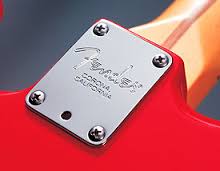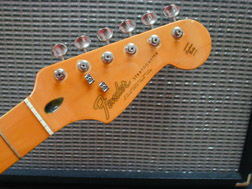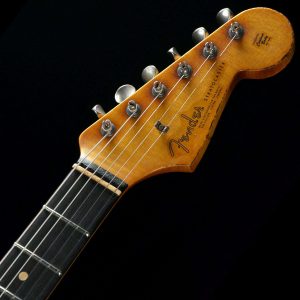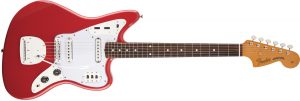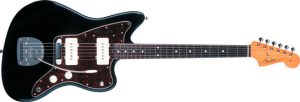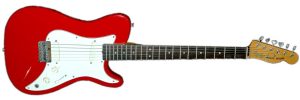Electric Guitar Guide – Guitar Style Overview Information
The stratocaster
 This is one of the most enduring electric guitar styles ever made. It was designed by Leo Fender in 1969 and although many copies are now available, those made by the Fender Company are understandably the models for reference and the professional’s choice. Very affordable versions are produced alongside the much revered and more expensive USA models. It has a slender solid wood body and two cutaways giving easy access to the upper frets. Each of three pickups gives a different sonic character depending on its position between bridge and neck. A selector switch allows for pickup combinations in unison giving a wide variety of tonal options for which the Stratocaster is renowned and recognised around the world. Words used to describe tones from the neck pickup include warm, deep, round, smooth and mellow and the bridge pickup should sound brighter and ‘sweeter’. It is the guitar synonymous with rock music emerging from the late sixties and seventies through to main stream rock played today.
This is one of the most enduring electric guitar styles ever made. It was designed by Leo Fender in 1969 and although many copies are now available, those made by the Fender Company are understandably the models for reference and the professional’s choice. Very affordable versions are produced alongside the much revered and more expensive USA models. It has a slender solid wood body and two cutaways giving easy access to the upper frets. Each of three pickups gives a different sonic character depending on its position between bridge and neck. A selector switch allows for pickup combinations in unison giving a wide variety of tonal options for which the Stratocaster is renowned and recognised around the world. Words used to describe tones from the neck pickup include warm, deep, round, smooth and mellow and the bridge pickup should sound brighter and ‘sweeter’. It is the guitar synonymous with rock music emerging from the late sixties and seventies through to main stream rock played today.
The body is typically made from Alder, although models in Ash, which is lighter wood, are also available. It is commented that, although Ash was used on the very first Stratocasters, the Alder body provides tones with warm low notes and clear mid-range tones, while the Ash bodies are said to produce a brighter tone over that range. Much also depends on the guitar’s set-up, its pickups, the amplification and its settings. The Ash models tend to be those used for translucent finishes, e.g. natural, honey and butterscotch, the wood grain being more evident as the wood grows more quickly and the bands in the grain wider.
Stratocaster Controls:
 Volume, Tone
Volume, Tone
Pickup switch
Plug insert
A volume control lowers or raises the output current from the pickups and there are two controls to adjust the tones. There can either a three position pickup selector switch for bridge, middle or neck pickup or a five position switch which additionally combines bridge with the middle or neck with the middle pickup, giving additional versatility of tones. Traditionally the bridge pickup was not wired to a tone control, but there can be a variety of configurations for how these controls are setup. The guitar can be easily customised with the pickups, their tone controls and wiring changed to suit the individual. These factors, combined with versatile tone, make the guitar a very attractive and popular option.
The fret board is in either Rosewood or Maple and the modern neck, which is bolted to the body, will have twenty two frets while a ‘vintage’ or reissue older models will have 21 frets.
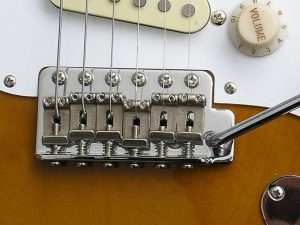 The bridge holds a tremolo arm via a metal block in the cavity of the body attached to springs concealed under a plate in the rear. The springs can be altered to ease or resist the tremoelo effect.
The bridge holds a tremolo arm via a metal block in the cavity of the body attached to springs concealed under a plate in the rear. The springs can be altered to ease or resist the tremoelo effect.
 Tremolo Springs Cover removed
Tremolo Springs Cover removed
showing tremolo block
and springs
Tips:
The bridge position pickup can sound particularly harsh and brittle if it is not of good quality. Listen out for this but check you are satisfied with the amplifier and its settings, eliminating these as a cause. It is generally commented and agreed that amplifiers not using valves tend to render tones that are harsher. Transistors, that replaced valves years ago, do work more efficiently, but can result in tones that lend nothing to the warmth and character of your instrument. For an electric guitar, the amplifier becomes an integral part of your instrument’s tone, pronouncing its sonic character.
The Telecaster
 Telecaster This is another Leo Fender guitar produced in 1951, a renaming of the Broadcaster released one year before that. The Telecaster is a relatively straightforward guitar and a favourite with the author. It is known for having a bright, cutting tone, simple in operation with just two, ‘single coil’ pickups and a three position switch that covers all the options when selecting either one or combining two. The body was originally made in Ash, and models later in Alder. The neck’s fret board is in either rosewood or maple with 22 frets on modern models, 21 on the older vintage reissue models of the 50s, 60s and 70s. The strings on a Telecaster are threaded through the body of the guitar then run over string guides on the bridge, a feature thought to contribute significantly to its sustained tone as the stings make firm contact with the body for sonic resonance.
Telecaster This is another Leo Fender guitar produced in 1951, a renaming of the Broadcaster released one year before that. The Telecaster is a relatively straightforward guitar and a favourite with the author. It is known for having a bright, cutting tone, simple in operation with just two, ‘single coil’ pickups and a three position switch that covers all the options when selecting either one or combining two. The body was originally made in Ash, and models later in Alder. The neck’s fret board is in either rosewood or maple with 22 frets on modern models, 21 on the older vintage reissue models of the 50s, 60s and 70s. The strings on a Telecaster are threaded through the body of the guitar then run over string guides on the bridge, a feature thought to contribute significantly to its sustained tone as the stings make firm contact with the body for sonic resonance.
 Telecaster Controls
Telecaster Controls
volume and tone
 Rear of Telecaster Rear of Telecaster
Rear of Telecaster Rear of Telecaster
showing string hole ferrules
Keeping it simple, there are just two controls, one for volume and the other governs the tone of both pickups. The neck pickup is set at a slant so that the higher notes are captured at their brightest. Although available in a variety of versions that make it popular among renowned blues players, pop rock and ‘indie’ bands, the sound of the Telecaster perhaps remains most famously associated with country music when set up and amplified in such a way as to feature the use of a characteristic, rich ‘twang’ tone.
Tips:
The bridge position pickup in particular can sound very harsh and brittle if it is not of good quality. Single coil pickups, do sound brighter than their ‘humbucker’ counterparts and the slanted setting of the Telecaster bridge pickup is designed to capture tones giving a more treble edge. Care is needed in listening for tonal adjustments, whether on the guitar itself or the amplifier, to avoid the tone being too harsh or overly bright.
Other Fender Guitar Styles
Fender do make guitars in other styles, examples are shown here. Some of these appear to have gained in popularity with those seeking, perhaps, a different image or sound to that which had already become popular. Other than body style and cosmetic appearance, technical differences can be seen as variations to the fitments of the Stratocaster and Telecaster guitars and synonymous with Fender guitar design and build, the detail of which is covered elsewhere in this website.
The Les Paul
 This has been produced by the Gibson guitar company since the 1950s, following up an idea and a design suggested by the legendary Les Paul, an exceptionally talented guitarist and, in the opinion of the author, a genius.
This has been produced by the Gibson guitar company since the 1950s, following up an idea and a design suggested by the legendary Les Paul, an exceptionally talented guitarist and, in the opinion of the author, a genius.
The choice of a solid a body made of mahogany and topped with maple adds not only to the instrument’s weight but also its sonic tonality and noticeable sustain. This is further enhanced by the fitting of two ‘humbucker’ pickups, a distinct characteristic of the Less Paul, and Gibson guitars generally.
The neck is made from mahogany with a rosewood fret board and has 22 frets. All fret boards are curved along the line of the fret and the Gibson guitars have flatter necks than the Fender Stratocasters and Telecasters reviewed above and, unlike them, the neck is glued to the body to form a solid one piece item – an important and further characteristic of the Les Paul and other Gibson guitars. 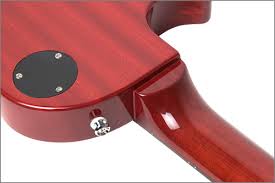
Each pickup has its own volume and tone control. A three position toggle switch selects either pickup, or combines both – the neck pickup position being labelled ‘Rhythm’ and the bridge pickup, with its more cutting tone, labelled ‘Lead’.
 The bridge comprises two pieces, a ‘tailpiece’ through which the strings are threaded and a ‘Tune-o-matic’ part over which the strings sit and which provides fine tuning of the guitar’s ‘intonation’.
The bridge comprises two pieces, a ‘tailpiece’ through which the strings are threaded and a ‘Tune-o-matic’ part over which the strings sit and which provides fine tuning of the guitar’s ‘intonation’.
 During the sixties, Gibson produced a slimmer guitar, the ‘SG’, with two cutaways unlike the Les Paul which obviously has only one. Les Paul was not happy with the SG and wouldn’t endorse it. It’s out there still as a rock guitar, an icon in the band AC/DC’s image, but the Les Paul, in various configurations has endured far greater popularity as exemplified through the blues of Mike Bloomfield and Peter Green, to the thicker, driven tones of Gary Moore and the style of rock emerging from the seventies with players such as Scot Gorman, the mainstay guitarist of the band ‘Thin Lizzy’.
During the sixties, Gibson produced a slimmer guitar, the ‘SG’, with two cutaways unlike the Les Paul which obviously has only one. Les Paul was not happy with the SG and wouldn’t endorse it. It’s out there still as a rock guitar, an icon in the band AC/DC’s image, but the Les Paul, in various configurations has endured far greater popularity as exemplified through the blues of Mike Bloomfield and Peter Green, to the thicker, driven tones of Gary Moore and the style of rock emerging from the seventies with players such as Scot Gorman, the mainstay guitarist of the band ‘Thin Lizzy’.

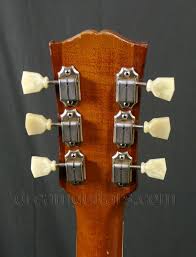 Les Paul Headstock with Schaler Tuners left and Kluson right
Les Paul Headstock with Schaler Tuners left and Kluson right
The guitar is undoubtedly versatile, as affirmed by the playing of Mr. Les Paul himself, an outstanding and excellent Jazz guitarist.
Tips:
The Les Paul, made from mahogany and having a solid body, is a heavy guitar, not comfortable for everyone. Over the years various forms of weight relief have been conducted whereby wood has been removed from the interior in the form of holes and chambers. This has lead to much discussion over the effect this may have had, or not had, on tone, so use your ears and own judgement if able to compare. Its two Humbuckers deliver distinctive and desirable tones of which one of two is generally used, either the bridge pickup with its bright yet ‘thick’ tones or neck pickup with its smoother, ’rounded’ tones. Guitars fitted with three pickups offer more versatility in tone and it is worth knowing before selecting your guitar that the ‘single coil’ pickups, as traditionally fitted to, for example, to a Stratocaster guitar, have a ‘thinner’ sound than the ‘fatter’ and fuller sound sound’ of guitars fitted with ‘Humbuckers’ such as the Les Paul. There are, of course, variations and single coil pickups may also be fitted, as originally, and known as PAF 90.
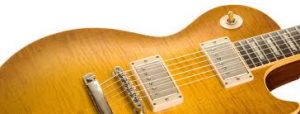 Les Paul fitted with Humbucker pickups
Les Paul fitted with Humbucker pickups
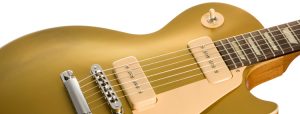 Les Paul fitted with P90 pickups
Les Paul fitted with P90 pickups
The ES 335
 The ‘335’ style guitar first appeared in 1958 and thereafter some modifications occurred, such as a more elliptical neck being one of them together with some cosmetic touches. The ES stands for ‘Spanish Electric’. Key to this Gibson guitar is its slim, semi-hollow body made from three ply maple and a solid centre block also of maple. This makes the guitar lighter in weight than the Les Paul reviewed above, but it is larger in size. The neck is made from mahogany topped with rosewood for the fretboard which has 22 frets and glued to the body to form a solid connection.
The ‘335’ style guitar first appeared in 1958 and thereafter some modifications occurred, such as a more elliptical neck being one of them together with some cosmetic touches. The ES stands for ‘Spanish Electric’. Key to this Gibson guitar is its slim, semi-hollow body made from three ply maple and a solid centre block also of maple. This makes the guitar lighter in weight than the Les Paul reviewed above, but it is larger in size. The neck is made from mahogany topped with rosewood for the fretboard which has 22 frets and glued to the body to form a solid connection.
 The pickup configuration is two ‘humbuckers’, each with its own volume and tone control. A three position switch selects each possible setting – neck, bridge or both pickups combined.
The pickup configuration is two ‘humbuckers’, each with its own volume and tone control. A three position switch selects each possible setting – neck, bridge or both pickups combined.

 The bridge is the ‘Tune-o-matic”, typical of a Gibson guitar, like that of the Les Paul, and there are models in which the strings are fed over the bridge via a different attachment to the end of the body.
The bridge is the ‘Tune-o-matic”, typical of a Gibson guitar, like that of the Les Paul, and there are models in which the strings are fed over the bridge via a different attachment to the end of the body.
The top of the body is arched and this, together with its characteristic f-holes, made it popular with Jazz and dance band players in the early years. With one slight variation or another, the guitar has been played by many a popular and well known players such as B.B. King (blues), Chuck Berry (rock) and Larry Carlton (Contemporary Jazz) and John Lennon and George Harrison of the Beatles (Pop). Similar in shape to the 335 is the 330 which is a hollow bodied guitar fitted with two single coil pickups in place of Humbuckers. 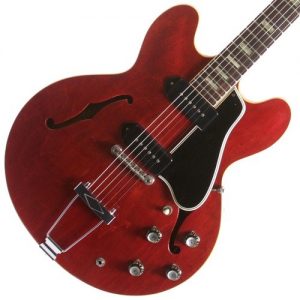
Tips:
The guitar is larger than some others and may not suit everyone, some wear it a little higher to the chest, particularly Jazz guitarists. But then again it all depends on the individual – you can do as you please – Chuck berry, you will notice, wore his quite low for his theatrical performances.
The tone too is characteristically more delicate than with the solid body guitars, but these things can be very shaped and assisted by the tonal settings of the amplifier as much as the guitar itself. I suggest you listen to the players I have mentioned above to discern its tone and versatility. I think also you will find the 335 played as a rhythm guitar on tracks such as Listen to the Music and Long Train Commin’ by the Doobie Brothers.
The ES 175
 ES 175The first of these was produced in 1949 by the Gibson guitar company, originally with one singe coil pickup (a PAF 90) which during the late 1950s and onwards was fitted instead with two humbucker pickups. It is a hollow bodied guitar, three inches in depth, and, like the ES 335, is made using three ply maple. The depth of the guitar is three inches, deeper than the other reviewed above. The neck, made of mahogany and with a Rosewood fretboard, has twenty frets and a fairly flat radius of 12 inches. Controls are generally typical of the Gibson style with two volume, two tone controls and a three position switch
ES 175The first of these was produced in 1949 by the Gibson guitar company, originally with one singe coil pickup (a PAF 90) which during the late 1950s and onwards was fitted instead with two humbucker pickups. It is a hollow bodied guitar, three inches in depth, and, like the ES 335, is made using three ply maple. The depth of the guitar is three inches, deeper than the other reviewed above. The neck, made of mahogany and with a Rosewood fretboard, has twenty frets and a fairly flat radius of 12 inches. Controls are generally typical of the Gibson style with two volume, two tone controls and a three position switch
 Bridge and string guide feature of the ES 175
Bridge and string guide feature of the ES 175
Tips:
In keeping with tradition and its origins, this guitar remains mostly identified with Jazz guitarists.

